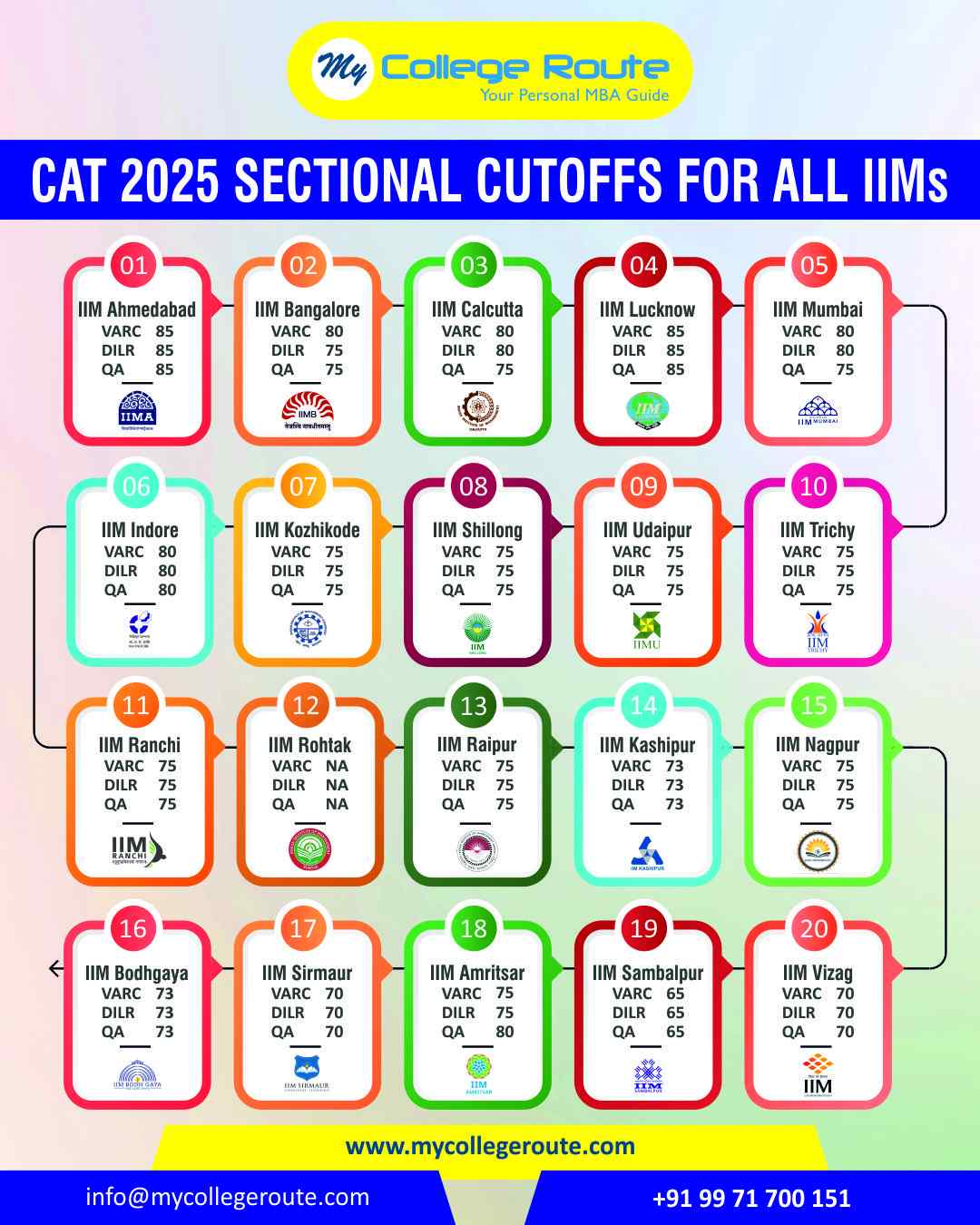CAT 2025 Sectional Cutoffs for IIM Admission 2026–28

The Common Admission Test (CAT) remains the gateway to India’s top management institutes, including the Indian Institutes of Management (IIMs). While most aspirants aim for a high overall percentile, the sectional cutoffs play an equally important role. Even with a percentile in the 98+ range, failing to meet sectional benchmarks in VARC, DILR, or QA can disqualify a candidate from IIM shortlisting.
For the 2026–28 MBA/PGDM batch, IIMs will shortlist candidates based on CAT 2025 performance, focusing not just on overall score but also on balanced ability across all three sections. This ensures students possess well-rounded analytical, reasoning, and communication skills.
This article presents the IIM-wise CAT 2025 sectional cutoffs along with insights on how aspirants can strategically prepare to meet sectional percentile targets.
Understanding CAT Sectional Cutoffs
The CAT exam evaluates candidates across three key sections, each assessing different managerial and analytical skill sets. The VARC (Verbal Ability & Reading Comprehension) section tests a candidate’s reading comprehension, language proficiency, and interpretation skills. The DILR (Data Interpretation & Logical Reasoning) section focuses on structured problem-solving and pattern recognition, examining how well a candidate can interpret data and apply logical reasoning. Finally, the QA (Quantitative Aptitude) section measures mathematical reasoning and numerical problem-solving ability, evaluating conceptual clarity and accuracy in quantitative concepts.
Each IIM sets minimum percentile thresholds in:
- VARC
- DILR
- QA
- Overall CAT score
Failing even in one section can result in no call, despite a high overall percentile.
Why Sectional Cutoffs Matter in IIM Admissions
(a) Ensures Skill Balance
IIMs want candidates who are not just strong in Maths or English but balanced thinkers.
(b) Academic Rigor Requirement
Core MBA courses require analytical, reasoning, and communication skills across domains.
(c) Reduces Luck Factor
High overall scores from a single strong section do not reflect managerial competency.
CAT 2025 Sectional Cutoffs for Top IIMs (2026–28 Admission)
(Presented in paragraph form, as per your requirement.)
IIM Ahmedabad
For IIM Ahmedabad, the expected CAT 2025 sectional cutoffs will remain on the higher side, with VARC around 85, DILR around 80, and QA approximately 85. As one of the most competitive institutes, IIM Ahmedabad focuses on balanced scores and strong sectional consistency to shortlist candidates.
IIM Bangalore
IIM Bangalore typically allows slightly lower sectional cutoffs than IIM Ahmedabad, but it still requires strong consistency. For 2025, VARC is expected to be near 80, DILR at 75, and QA also at 75, ensuring a well-rounded academic profile.
IIM Calcutta
IIM Calcutta prioritizes quantitative and analytical depth. Its cutoffs stand at 80 in VARC, 75 in DILR, and 75 in QA, maintaining competitiveness while slightly relaxing verbal sectional demand.
IIM Lucknow
Like IIM Ahmedabad, IIM Lucknow also requires strong scores in both VARC and QA — typically 85 each — and in DILR, usually 80, along with 80 in DILR. Candidates aiming for IIM Lucknow must display excellent reading comprehension and quantitative accuracy.
IIM Mumbai (NITIE Converted IIM)
With its strong operations and analytics orientation, IIM Mumbai requires 80 in VARC, 80 in DILR, and 75 in QA, valuing consistent academic aptitude.
IIM Indore
IIM Indore maintains balanced sectional cutoffs: 80 in VARC, 75 in DILR, and 80 in QA, favoring candidates with strong reasoning and mathematical foundations.
IIM Kozhikode
IIM Kozhikode maintains moderate sectional benchmarks — 75 across VARC, DILR, and QA — making it accessible to consistent performers.
IIM Shillong
IIM Shillong is expected to keep 75 percentile across all three sections, emphasizing conceptual clarity over extreme percentile peaks.
IIM Udaipur
The cutoff trends for IIM Udaipur continue at 75 in all sections, making it favorable for candidates targeting mid-to-high percentile ranges.
IIM Trichy
IIM Trichy expects 80 in VARC and 75 in both DILR & QA, allowing slight flexibility for quant candidates.
IIM Ranchi
IIM Ranchi continues to maintain a 75 percentile across all CAT sections, maintaining an accessible selection profile.
IIM Rohtak
IIM Rohtak uses a unique criterion and may not enforce strict sectional cutoffs (evaluations are holistic), though VARC generally remains around 75.
IIM Raipur
IIM Raipur usually requires 73 in VARC, and 75 in DILR & QA, balancing competitive and inclusive selection.
IIM Kashipur
IIM Kashipur retains 73 percentile benchmarks in all sections, enabling strong aspirants to secure calls at mid-tier performance levels.
IIM Nagpur
IIM Nagpur demands 75 in VARC, DILR & QA, rewarding steady performers.
IIM Bodh Gaya
IIM Bodh Gaya typically accepts 73 percentiles in all three sections, giving aspirants a realistic opportunity.
IIM Sirmaur
IIM Sirmaur’s requirements remain 70 percentile across all sections, making it one of the more accessible IIMs.
IIM Amritsar
IIM Amritsar expects 75 in VARC, 75 in DILR, and a slightly higher 80 in QA, reflecting emphasis on quantitative strength.
IIM Sambalpur
IIM Sambalpur maintains 65 across all sections, making it open to developing managerial potential in diverse candidates.
IIM Visakhapatnam
IIM Vizag usually requires 70 percentile across all three CAT sections, with a focus on academic and interview performance.
Expected Overall Percentile Range for Calls
The expected overall percentile range for IIM calls varies across IIM categories. For the Top 6 IIMs — which include IIM Ahmedabad, IIM Bangalore, IIM Calcutta, IIM Lucknow, IIM Indore, and IIM Kozhikode — candidates generally need to score between 97 to 99 percentile and above to secure interview shortlists. The newer IIMs, such as IIM Udaipur, IIM Trichy, IIM Raipur, and IIM Ranchi, typically shortlist candidates with overall percentiles in the 94-96 range. Meanwhile, the Baby IIMs — including IIM Nagpur, IIM Amritsar, IIM Sirmaur, IIM Visakhapatnam, and IIM Bodh Gaya — generally consider candidates with percentiles in the 88-94 bracket, depending on profile strengths and category-based relaxations.
How to Clear Sectional Cutoffs Strategically
A. VARC
- Read editorials daily (Indian Express, Mint, Aeon)
- Practice RC drills with time control
B. DILR
- Solve sets by pattern type (games & logic/tables/networks)
- Take sectional timed mocks
C. QA
- Master arithmetic, algebra, and number systems first
- Aim for high accuracy, not just attempts
Prof. Route’s Advice
“Clearing sectional cutoffs requires strategic preparation, not just hard preparation. Focus on consistency across sections. Remember—balance is the key to an IIM shortlist.”
– Prof. Route, MyCollegeRoute.com
FAQs
Q1. What happens if I score above the overall cutoff but below the sectional cutoff?
You will not receive an IIM call, even with a high overall percentile.
Q2. Is 95 percentile enough for IIM calls?
Yes—for new & baby IIMs. For top IIMs, aim 98+.
Q3. Which section is the toughest to clear?
Most aspirants struggle with VARC, especially RC accuracy.
© 2025 mycollegeroute.com All Rights Reserved. Website designed by Orbit Inhouse

